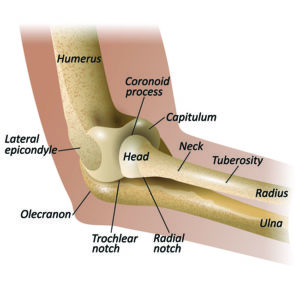What Are Elbow Fractures?
The elbow is extremely vulnerable to injury from force or repetitive use. Elbow fractures can range in severity but always need medical attention for proper healing to occur.
Causes of elbow fractures may result from:
- A fall on the elbow
- A direct blow to the elbow
- twisting injury to the arm
- A fall on an outstretched arm with the elbow locked in extension
 Anatomy of the elbow
Anatomy of the elbow
The elbow is a hinge joint covered in cartilage where three bones meet: the humerus (upper arm bone), ulna and radius (both forearm bones). The knobby portion of the elbow where the radius and elbow connect is called the radial head. The pointed end of the elbow is the olecranon, the cup-shaped end of the ulna--and is most exposed for injury.
Symptoms of an elbow fracture
An elbow fracture can be a break in one or several places. A snap or pop at the time of the injury may be felt or heard. The break can be internal or the bone fragment can break the skin, which is called an open fracture. In addition to pain and an inability to move the elbow through a complete range of motion, symptoms of elbow fractures include:
- Swelling
- Tenderness
- Bruising or redness
- Sharp, intense pain
- Numbness in the elbow, forearm, hand, and/or fingers
Types of Fractures
There are multiple types of fractures that can occur from a fall, blow to the elbow, or injury resulting from twisting the arm. In addition to a fracture, other injuries such as dislocations, sprains, and strains might occur.
Olecranon fracture
The olecranon is the tip of the elbow and is not covered by muscles or ligaments, making it especially susceptible to breaks. During a fall, sometimes the tricep muscle contracts (also called an eccentric contraction), bending the elbow into a sharp angle and making it a focused target for impact.
Distal humerus fracture
The distal humerus is the upper section of the joint and connects the elbow and the shoulder. If the elbow receives a strong blow, a fracture may occur. These fractures can also be a result of falling on your hand if the elbow is straight.
Radial head fracture
The radius meets with the humerus at the elbow joint. The radial head is part of this bone. If you fall and put your hand out, the impact can force the radial head into the bottom of the humerus, causing a fracture.
Diagnosing an Elbow Fracture
A diagnosis for a possible elbow fracture includes a physical examination as well as imaging. First, Dr. Donnelly will talk with you about your medical history and general health. He will examine your elbow, checking for lacerations and areas of tenderness. By checking your pulse, he can determine if there is blood flow to the hand and fingers. Dr. Donnelly may order x-rays to determine if a fracture has occurred or if bones have been dislocated. If additional imaging is need, a CT (Computed Tomography) scan or MRI may be ordered.
Treatment options
If you believe you’ve fractured your elbow, seek medical attention as soon as possible. Until you are able to see a physician, apply ice and immobilize your elbow the best you can. There are nonsurgical and surgical options for treating an elbow fracture.
Nonsurgical
If the bone has a simple break and the bone isn’t displaced or shattered, the elbow can be put in a cast or splint. By keeping the elbow immobilized, the fracture will be allowed to heal on its own. Healing time is roughly six weeks.
Surgical
Surgical treatment may be needed for displaced fractures that involve improper bone alignment and/or multiple pieces of fractured bone. An open reduction internal fixation procedure may be used to put the bone pieces back in their original place. Screws, pins, or wires are then used to hold those bones together. Sometimes, if the break has resulted in a fragment that can’t be repaired because it’s so small, it may be removed.
